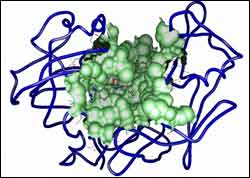Networking computers to help combat disease

3D structure of a target protein from Plasmodium falciparum (Credit: SCAI Fraunhofer)
Subtropical diseases lay waste to millions of people each year. In the quest to find a cure scientists are using Grid computing, the major driving force for new approaches towards collaborative large-scale science, to discover new drugs and better understand the diseases.
Last year there were about 350-500 million infections and approximately 1.3 million deaths due to malaria, mainly in the tropics. Malaria is spread by female mosquitoes, which carry protozoan parasites called Plasmodium.
Currently drug discovery seeks compounds that can inhibit or kill invading parasites and infections, but there are potentially millions of candidate compounds. It can take 10 years to discover a drug and another 10 to get it approved.
Grid technology, where the resources of many computers in a network are applied to a single problem at the same time can reduce candidate compounds from millions to thousands or even hundreds, isolating the most promising candidates and speeding up the discovery process.
The new research is particularly important because these diseases are comparatively neglected by large pharmaceutical companies. “The idea for malaria came from a conversation I had with a friend, a pastor who works in Burkino-Faso, who told me that malaria is the biggest problem faced by the country,” says Dr Vincent Breton, Research Associate at France’s Corpuscular Physics Laboratory (CNRS-IN2P3).
“Quite often it’s just the developed world that benefits from high-technology like Grid computing. I wanted Grids to benefit Africa,” says Breton.
Two European projects are currently searching for candidate treatments, the Enabling Grids for E-sciencE (EGEE) project-based Wide In Silico Docking on Malaria (WISDOM), and Swiss Bio Grid’s DENGUE project. This type of research contrasts with in vitro and in vivo approaches and is now a hugely important first step in large-scale biological analyses.
Using the FlexX software developed at the Fraunhofer Institute and donated by the BioSolveIT company, WISDOM used the EGEE Grid to match 3-dimensional structures of proteins from the malarial parasite to ligands, chemical compounds that bind to protein receptors.
“Grids are particularly well suited to drug discovery because you can compute the probability for one ligand to fit, or ‘dock’, to one protein on each computer node in the Grid, giving massive parallelism,” says Breton.
It takes between a few seconds and a few minutes to model whether there’s a match between a protein and a ligand, and the WISDOM project performed the equivalent of 80 CPU-years of calculations in just six weeks.
Analysis of WISDOM results at Germany’s Fraunhofer Institute for Algorithms and Scientific Computing (SCAI), joint instigators and participants of the project alongside France’s CNRS-IN2P3, allowed the 1,000 most promising compounds out of 1 million candidates to be selected using a relative ranking scale between different ligands. The project identified both known candidates and new ones, which demonstrated the validity of the approach.
“Now we will use a supercomputer to even more precisely model the match between the candidate ligands and the proteins,” says Breton.
Refined docking requires intensive computation because researchers must account for molecular dynamics. “There are a lot of atoms and we want to model how they interact with each other to further refine the ranking order of candidate compounds,” says Breton. Grid computing works excellently for computation of large data sets that can be broken down into discrete tasks, while supercomputers excel at modelling highly interconnected data sets.
Drug discovery is probably the most exciting use of Grid technology in the battle against disease, but it is not the only one. The Africa@home project allows people to donate idle CPU cycles in a distributed infrastructure to perform epidemiological modelling. This enables researchers to calculate the impact of vaccines, for example, or the spread of a disease.
“But that’s not the only way to use Grids in epidemiology,” says Breton. “They could also be used to federate databases collecting data on infection and treatment in malaria and Dengue, but also in HIV. This is vitally important information that is currently very difficult to collect in Africa.”
“This project shows the importance of Grid technology, and the value of a resource like EGEE,” concludes Breton.
Media Contact
All latest news from the category: Information Technology
Here you can find a summary of innovations in the fields of information and data processing and up-to-date developments on IT equipment and hardware.
This area covers topics such as IT services, IT architectures, IT management and telecommunications.
Newest articles

Retinoblastoma: Eye-Catching Investigation into Retinal Tumor Cells
A research team from the Medical Faculty of the University of Duisburg-Essen and the University Hospital Essen has developed a new cell culture model that can be used to better…

A Job Well Done: How Hiroshima’s Groundwater Strategy Helped Manage Floods
Groundwater and multilevel cooperation in recovery efforts mitigated water crisis after flooding. Converting Disasters into Opportunities Society is often vulnerable to disasters, but how humans manage during and after can…

Shaping the Future: DNA Nanorobots That Can Modify Synthetic Cells
Scientists at the University of Stuttgart have succeeded in controlling the structure and function of biological membranes with the help of “DNA origami”. The system they developed may facilitate the…



